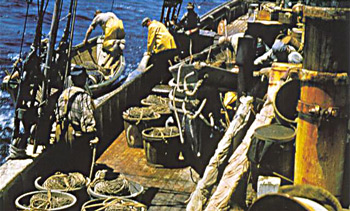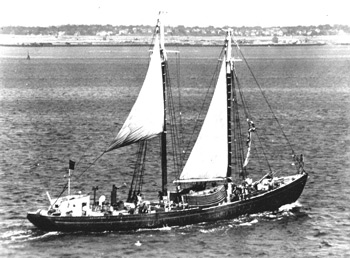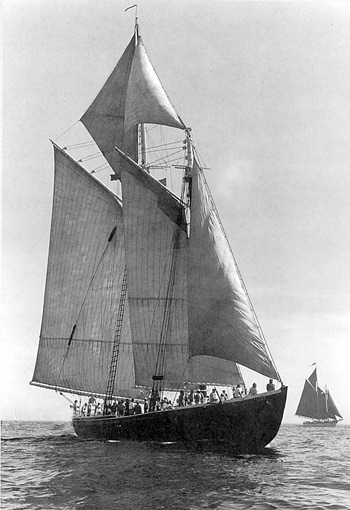Adventure, Living Up To Its Name
by Steve Cartwright

Deck of the Adventure during active fishing years. On deck are the tubs of trawl line and hooks. The dory being boarded will be loaded with the baited tub trawls. Two fishermen per dory would have set and hauled three loads of trawl lines in a day. Schooner Adventure Photo
Someday, the 84-year-old schooner Adventure will sail again.
Preservation of a seasoned piece of Gloucester’s famed fishery is underway, and this one-time Maine windjammer just needs a lot of friends, and maybe another million dollars, to be rolling along, gracing the sea as it has already done for eight decades.
Capt. Jim Sharp of Camden, who years ago rescued the last of the Grand Banks dory-fishing fleet and restored it as a passenger vessel. Twenty-two years ago, ready for different challenges, he turned the 121-foot Adventure over to the people of Gloucester, for free.
But fixing up an old boat is anything but free, and as the vessel’s spokeswoman Joanne Souza put it, “Another million dollars and we can have most of the bells and whistles we want. People are a little weary of it taking so long,” she lamented. Already more than $2.5 million has been spent rebuilding Adventure’s veteran hull. In 1926, it cost owner Jeff Thomas about $65,000 for Adventure, fully fitted out.
“We’re definitely on a shoestring,” said Souza, who heads the Gloucester nonprofit group committed to seeing Adventure sail again. She celebrates every gift, from $2,000 earlier this year for new dories, to $100,000 to continue restoring the hull. She estimates about 15 percent of the white oak and yellow pine in the vessel dates to the original 1926 heavy construction. Adventure was built by the James & Son yard in nearby Essex for Captain Thomas. Hundreds of spectators watched as12-year-old Natalie Thomas smashed a bottle of champagne over the bow.
It may be quite a while before Adventure is re-launched, but supporters are confident that day will come. The idea is to create a functional, experiential tribute to the thousands of fishermen from Gloucester who sweated and shivered and rowed and hauled and sometimes did not return from the sea. Captain Sharp, who now runs a Rockland marine museum, re- quested that Adventure “continue to be cared for, prominently displayed as a monument to the city of Gloucester, and used for the education and pleasure of the public.”
The group restoring Adventure wants it to be a floating classroom teaching both environmental and historical lessons. Many U.S. Coast Guard requirements must first be met, including such things as watertight bulkheads. Even with modifications from the original, the group hopes to remain faithful to Adventure’s fishing design, meeting federal standards for historic preservation. Sixteen years ago the schooner received the honor of being designated a National Historic Landmark, an odd title for a boat.
Souza said, “There aren’t too many things that break. It will definitely be a hands-on museum.” She believes children as young as kindergarten can learn from an onboard experience.
Souza, who grew up in a fishing family in Rockport, Massachusetts, said there are still older people around who remember the last fishing trips Adventure made in her 27 years sailing out of Gloucester and Boston.

Adventure sailing out of gloucester to fish on George's Bank. Schooner Adventure Photo
Adventure was known as a swift and seaworthy vessel, a highliner and the most profitable Gloucester fishing schooner on record. Its crews landed an estimated $4 million worth of cod and haddock over the years. By1953, her final fishing voyage, Adventure was the last dory trawler at work. Remarkably, photographer John Clayton documented the final fishing days of the Adventure. For the next three decades, the vessel was the queen of the Camden windjammer fleet, taking tourists on short voyages that included lots of live music and lobster.
During her Camden years, Adventure served a stint as the We’re Here in a re-make of the movie version of Captain’s Courageous by Rudyard Kipling. The original movie used a sister schooner in the 1930s.
There are some salty quotes and stories about Adventure, including this one from her long-time skipper, Newfoundlander Captain Leo Hynes, during the dory-fishing years: “Fishing? A rugged life. Not fit for a human being.”
That quote and much more information appears in a book called Adventure by Joseph Garland of Gloucester, assisted by Captain Sharp. The book mentions a hard reality, five Adventure sailors lost at sea. Garland—also author of a gripping story of doryman Howard Blackburn’s survival called Lone Voyager—said Adventure was aptly named. Garland, descended from fishermen, was friends with the late Gordon Thomas, whose father had Adventure built.
In March 1940, two dories were caught in dense fog while fishing off Nova Scotia. Four men were missing, including Captain Hynes’ brother. What often was tragic had a happy ending when two of the men were picked up by another fishing boat, eventually returning to Boston. The other two men, in the second dory, had missed Cape Sable and sailed into the Bay of Fundy where a British freighter found them. They hadn’t eaten in 42 hours and it was bitter cold but they recovered to fish again on the remainder of Adventure’s voyage, taking a train to meet the boat.
In April 1948, as Garland’s Adventure book tells it, the schooner had sprung a leak 40-50 miles east of Cape Cod in rough seas, with 100,000 pounds of haddock in the hold. The vessel carried 24 dory men and 14 dories—two being spares. Water was gushing into the engine room; one of two bilge pumps didn’t work. Crewman Henry Abbott remembered bailing with coffee cans and hoisting water from the still-empty aft hold while keeping an eye for rogue waves: “Gale of wind. Dark. It was bad.”
The men pumped all night, with a modern trawler and a Coast Guard cutter standing by. Gradually, Adventure motored to Boston and safety, where fish were off-loaded before a trip back to a marine railway in Gloucester.
Adventure survived but her hard-knocks fishing days were numbered. There were easier ways than dory fishing, which dated at least to the 1620s when Europeans settled on Cape Ann. Those were the days of salt cod, so well preserved it could be shipped all over the world. Garland called it a form of currency, “worth its weight in anything that could be bartered—from sugar to rum, figs to fine wines, white lace, black slaves, hymns by the trunkful, and spinets to play them on.”
Even as Adven- ture slid down the ways, the age of sail was ending, and this schooner made many fishing voyages under diesel power. But Adventure is a survivor. She was born again as a “windjammer,” the colorful name for vessels that take tourists seeking romance and adventure to sea.

Adventure under full sail coming back into Gloucester. Schooner Adventure Photo
By the 1980s, the ravages of melting ice from her fishing era — freshwater rots wooden hulls fast — and other aspects of aging. left Adventure in the lurch. Coast Guard officials were threatening Captain Sharp with loss of his “grandfathered” certification to carry up to 37 passengers for hire. In 1988, the Coast Guard pulled the license and Sharp had to cancel his already-booked summer season.
Finally, on August 25, Captain Sharp set sail for Gloucester. On board was former Capt. Hynes, 88, and his wife Lillian, who had never before sailed on the schooner her husband commanded. Adventure swept toward Cape Ann on a southeast gale, then had to be towed for a way before finding a light breeze to sail into her homeport to cheers and many escorting vessels.
Ten days later Adventure, with Sharp at the helm, won a Labor Day schooner race.
In his book Garland sounds a warning bell for those in the fishing industry today: “The world’s oceans are in dire danger from harvesting methods proven to be incalculably destructive to the fish and their habitat. There must be a return, with modern technology, to the resource-selective and habitat-kindly hook-and-line fishery exemplified so successfully by Adventure and her crew.”
When Sharp rescued Adventure, he recalled, “I re-rigged her, gutted her. The Adventure is my first born. Sailing the Adventure,” he wrote in his autobiography, With Reckless Abandon, “was to me like sailing a living museum.”
The Adventure continues.
For more information, and to join, donate or volunteer, visit the web at www.schooner-adventure.org or write to Schooner Adventure at Box 1306, Gloucester MA 01931.
